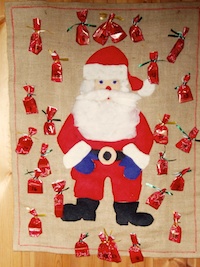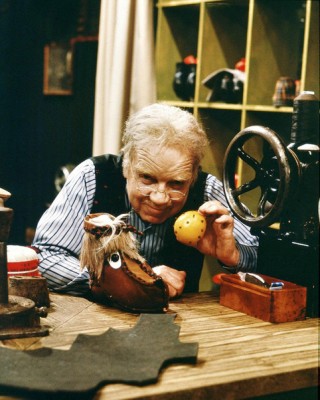
The advent calendar my parents
prepare for my sister and me
For the benefit of our international readership, I will present a series of articles about Christmas traditions in Norway. Some of these may be traditions in other countries as well, while others (like Lutefisk) are probably only found in Norway, and even here only among a crazy minority. My goal is to write one of these articles each day until Christmas Eve, thus making this series an example of todays topic: the Advent calendar.
The Advent calendar is, I imagine, known in most countries where Christmas is celebrated. At least the kind you get from the shops, where you open a small door and find a piece of chocolate inside. In Norway, however, we have two varieties which may not be that common elsewhere. The first is the homemade variant of the one with the chocolate. It usually consists of some sort of framwork, to which 24 small gifts can be attached. In the case of a home made calendar, the gifts will usually be a piece of chocolate or candy. We also had a calendar like this in the classroom when I was in school where each pupil (we were 24 in my class, very convenient) would bring a tiny wrapped gift, and then one pupil would be selected to open one each day.

From left: Tøflus, Jens Petrus and orange
Another variety, which is more focused on the countdown than the material side of the calendar, is an orange with 24 dried clove buds inserted in through the skin. This simple and very traditional advent calendar would often be hanging from a ribbon in the window, or something similar, and the idea is simply to remove one clove bud each day, counting down until Christmas.
In addition, there is the TV calendar for children. Essentially, this is a TV series with 24 episodes, usually with the story taking place during advent. According to
Wikipedia, this tradition is found in the Scandinavian countries plus Finland, and was first begun in Sweden in 1960. The classical example of this in Norway is
Jul i Skomakergata (Christmas in Shoemaker Street), featuring shoemaker Jens Petrus Andersen, who starts out with 24 pairs of shoes and hands off one each day during advent, and his talking slipper Tøflus, who lives in a drawer, eats parsley and shows Eastern German communist propaganda videos.
Jul i Skomakergata was made in 1979, and has been sent numerous times since then. If I remember correctly, all the different TV advent calendars when we were young were meant to be somewhat educational and/or promoting good values, as is proper for state sponsored children's television. In later years, however, several calendars of a more humorous nature have been made. The classical example of these is
The Julekalender. I quote a synopsis of the plot from wikipedia:
A long time ago, in ancient Trøndelag, the nisses lived merrily in their caves, unknown to the human populace of Trondheim.
One day, the wicked nåsås arrived. The nåsås killed many nisses and drove them out of their caves. The only cave the nåsås missed hid the Den Store Kloke Boken (the big wise book). If nåsås ever possess the Boken, they will discover the secret to increasing tax rate up to 100% and infiltrate all positions of bureaucracy and rule the world.
The good old gammel nok, the surviving leader of the nisse, sent the three bravest nisses, Hansi, Fritz and Günther, on a quest to find the winding key of the play dose, a musical box playing his life-tune. Good old gammel nok warned our heroes of the dangers of the nåsås and gave them the 'Den Store Kloke Boken' to consult for wisdom.
Tomorrow: something else.
-Tor Nordam



Comments